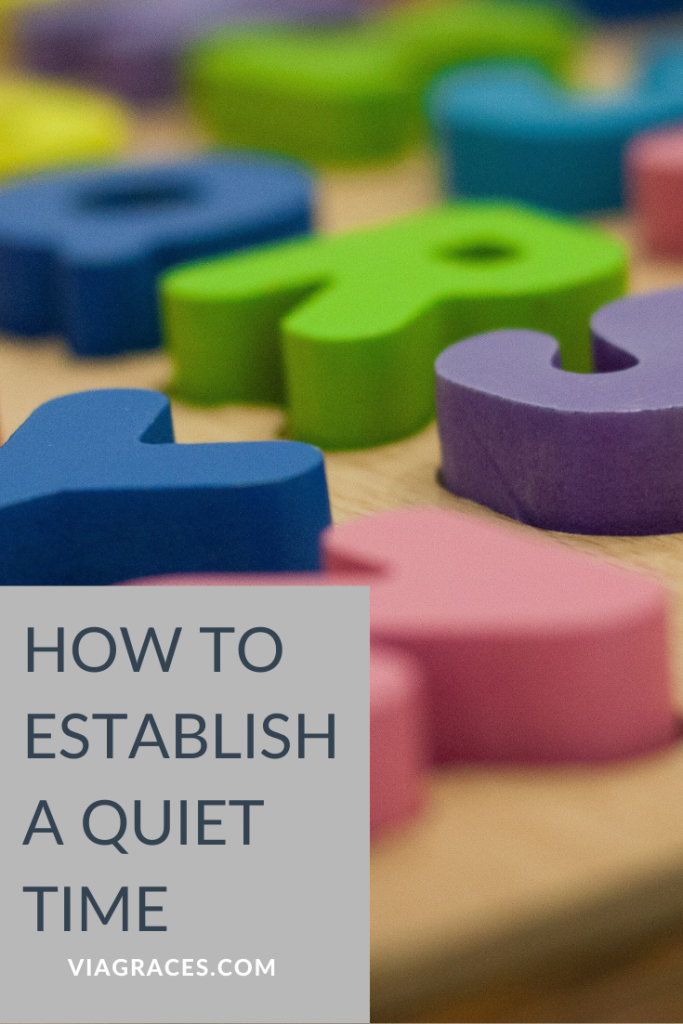My oldest was NOT an independent player when we transitioned from napping to quiet time. She didn’t even like being in a room by herself! So when the time came to drop her last nap, I was nervous.
But I put on my former elementary teacher hat to figure out how we were going to make this quiet time thing happen, because she still needed some kind of midday rest time, and my husband and I certainly needed that rest time, too!
Although it certainly takes time, teaching, and practice, your little one is so capable of having a consistent afternoon quiet time, and I’d love to teach you how! So in this blog I’m going to share:
- What quiet time is (and what it’s not) and why it’s so helpful when your child no longer naps
- How to set up a daily quiet time
- The best quiet time toys and activities
And so much more!
What is Quiet Time?
First, I’m going to say what quiet time is not. Quiet time is NOT sleep time! I therefore do not recommend “quiet time” be your toddler sitting in their bed quietly with books and quiet toys.
This is for a few reasons:
- We want their bed to be a place for sleep, not play!
- They might accidentally fall asleep! This then defeats the purpose of quiet time, especially if it replaced their nap time and their nap time was causing bedtime challenges.
- And three, asking your child to stay in one spot reading to themselves for an extended period of time just doesn’t feel realistic, so it’s like setting yourself up for an even greater challenge.
I also want to note that in our house, quiet time doesn’t need to be quiet! It generally is, because our girls are playing on their own, but the “quiet” piece we’re looking for isn’t noise level, but not engaging with each other or us. So if they’re banging a xylophone or singing a song or legos are clanging together, no worries!
When I say quiet time, I’m talking about a time when kids are doing something on their own (that’s not sleep) and parents are doing something else. There’s not really interaction going on – it’s a rest time for all!
For some families, quiet time just means independent playtime, while for other families it might just be screen time. In our house, quiet time looks like our girls playing on their own for 45-60 minutes, followed by a big clean up (“clean time before screen time”), and then 30ish minutes of screen time.
As a stay-at-home but also work-from-home mom, this is often when I get some work done – maybe checking emails or creating content. Sometimes I clean, work out, read, or just breathe.
In different seasons of life and parenthood, what quiet time actually looks like will likely be different for your family!

Now let’s talk more quiet time logistics…
Where Quiet Time Should Take Place
When we first introduced quiet time to both of our girls, it was in their bedroom. Having the boundary of, quiet time happens in your bedroom, was really helpful when we first started.
Once our girls started room sharing and our youngest needed their room to nap during quiet time, our oldest’s quiet time moved to the living room. Because quiet time was first set up in her room, she understood that even though she was in the main living area, it was still independent playtime.
Similarly, when our middle daughter started quiet time, we set it up with the boundary of staying in her room. However, once she was in a routine, the girls started taking turns who got to play in their bedroom versus the living room.
Fast forward a couple of years and they can now choose where they’d like to be for quiet time, and that often changes in the middle of quiet time. As long as they’re playing on their own, it works!
When Quiet Time Should Be
Because young kids thrive on routine, we recommend picking a general time of day and trying your best to stick to it! It generally works well to simply replace that old afternoon nap with a quiet time, which is right after lunch.
As our girls have gotten older or depending on what time the youngest is napping, we’ve been able to move quiet time around a bit, but in general, aiming for after lunch seems to work well for most families.
How to Set Up Quiet Time
1. Have a quiet time routine
Just like we have nap and bedtime routines, I recommend establishing a quiet time routine! This was actually 2.5 year old Olivia’s idea, and it makes so much sense.
When we first set up her quiet time, our “routine” would be to simply go to the bathroom, get her water, then lay out her activities. But one day she was having a tough time with me leaving and she said, “I need snuggles, can we read a book?”
Of course, why didn’t I think of that?!
So we started reading before quiet time and then we’d give a big hug and smooch – it was one last sweet time of connection and snuggles before expecting her to play on her own. And now to this day, four years later, we still read a book before quiet time – usually two books, actually, because now both girls get to choose one.
So now your toddler is done napping, you’re switching it out for quiet time, you’re making quiet time a routine, but HOW do we actually make quiet time happen?
2. Have an end goal, but start with a reasonable and attainable amount of time and work your way up
This comes straight from my teaching days. I mostly taught first and second grade, and we had a silent reading time every day. The goal was about 20 minutes, but you can’t expect a group of 25 six-year-olds to read to themselves for 20 minutes a day on the first day of school! Not going to happen.
We had to build up their stamina and make sure we were only letting them practice the right way. If we started off expecting a 20-minute silent reading time, we’d spend the entire 20 minutes reminding this one to be quiet, this one to stop moving from chair to chair, this one to actually look at a book rather than out the window, etc. It’d be 20 minutes of whack-a-mole. And guess what? We’d basically be establishing a routine of , silent reading means I tell you to read silently but you don’t really so I spend the time telling you to silently read…
Instead, we started small, and it’s the same with quiet time!
If you put your three-year-old in their bedroom, set a timer for 45 minutes, and say see you later, GOOD LUCK! They will come out of their room, say they don’t want to play, and you’ll spend those 45 minutes telling them they should be playing independently and they’re saying no!
So what’s happening? Quiet time now means mom and dad say play by yourself, I don’t want to, and we duke it out the whole time. THAT’S NOT QUIET TIME! And it sounds so frustrating and exhausting, so don’t do that.
When we started with Olivia, our end goal was an hour, but we started with seven minutes and slowly inched our way up. Yes, that meant I really didn’t get a quiet time that day, or really that month, but it was worth it for the long haul.
Once she understood how the timer worked and got comfortable with the process, we were able to start jumping up in bigger increments. But we had to practice the right way first!

I don’t remember exactly what it looked like, but it was probably 7-10 minutes for a solid week or so, and once she was consistently doing well there, maybe we jumped to 12-15 minutes for another week, built up that muscle, then 20, maybe 25, 30, 40, 50, and finally 60. All that to say, it took TIME!
And that time was so very worth it to build up that muscle of independent play, and to only practice in the way we expected her to do it.
I think we started around 10 minutes with Avery and were able to jump up more quickly, as she was a more independent player at that point, so use what you know about your child and go from there.
Check out the best quiet time timer here! It visually shows how much time has been set and you can see the red slowly disappear as time moves on. So without understanding the full concept of time, your toddler can see the red getting smaller, so they know time is passing and quiet time is almost over.
Establish Quiet Time Rules
Just as we sometimes need to establish bedtime boundaries with our big kids, it’s important that your child knows their quiet time rules!
Quite simply, Olivia’s rules were to stay in her room and play independently (and yes, we used the word “independently”!). But a rule isn’t a rule unless it’s enforced, and we can do so with rewards and consequences.
So if your child leaves quiet time because they just don’t want to do it, always walk them back to their room and remind them of the rules.
In the beginning, especially, if Olivia was hesitating, I’d remind her of the rules and tell her if she stays in her room and plays independently, I will come check on her – it was a natural reward! That anticipation alone *almost* always encouraged her to follow through, and it was easy for me to take a minute to go check on her and encourage her!
Similar to when we potty trained, we also rewarded our girls with a vitamin gummy bear when they stayed in their room the whole time. So if they came out and were pushing boundaries a bit, we’d remind them that if they came out again, they wouldn’t get that gummy. And that almost always did the trick!
But within maybe 3-4 weeks, they forgot about the treats because we were now in routine, and they mostly looked forward to the big hug we gave them and hearing, “I’m so proud of you.”
Some people use screen time as the natural reward/consequence for quiet time – when their little one has a great quiet time they get screen time after, or if they come out lots and need reminders, they don’t get screen time. Personally, that screen time is a tool we use as a continued reset for all, so I wouldn’t want it to be determined by a successful quiet time.
Or maybe if they leave their room, you walk them back with a reminder, and they leave again, you could hold the door closed for one minute, and then again remind them of the rules.
We simply want our kiddos to know what’s expected of them in quiet time and we want to have some sort of system in place so they actually follow through!
So instead of quiet time always being a fight, you start slow, lay those boundaries down and only practice the right way, so eventually it’s a long, beautiful, and consistent quiet time!
The Best Quiet Time Toys and Activities
When we first established quiet time for Olivia, my vision was that I’d have a quiet time basket with a few activities in it and I’d rotate those activities every few days or every week. But two months into quiet time, my creature-of-habit toddler was quite happy with the same activities she started with, so when I tried to change out even a puzzle, she wasn’t having it.
So she had the same basket every day and loved it. I tried choosing activities that she could use independently and that were open-ended in use, so the possibilities were endless! Her basket included:
- Magna-Tiles (quiet time aside, these have by far been a favorite toy of ours, and they’ve been a favorite for over a year now!)
- Jumbo Coloring Pads (really any coloring book will do, these are just perfect for younger kiddos!)
- Colored pencils (we color with crayons and markers regularly, so colored pencils feel extra special)
- A baby doll
- Peg puzzles (pro tip: place them inside mesh laundry bags to make clean-up quick and easy!)
- Books, lots and lots of books
- Beading/lacing activities
- Dominoes
Other Great Quiet Time Toys/Activities:
- LEGO
- Cars, trains, tracks
- Animals
- Dollhouse
- Barbies
- Play Kitchen
- I Spy Books
If you choose to create a quiet time basket (maybe even toys they only get to use during quiet time to add some extra incentive!), make sure they can use them all independently and safely! You don’t have to open anything, help hold something, or be terrified of them destroying things.
Final Quiet Time Tips
- If a daily quiet time is your norm and you go on vacation, or you’re visiting family for a few days, consider having some sort of quiet time! I remember going to the Outer Banks and we made sure one of Avery’s naps was at our vacation house, whenever possible. So most days we set Olivia up with a quiet time while there! Both to keep the consistency and routine of quiet time, but also for her to get that physical reset. When we can’t do an official quiet time while we’re away or that just feels silly for where we are, we try to still give our girls 20-30 minutes of screen time to just get that reset. Especially when we’ve been doing extra fun adventures or we’re around lots of people, that midday downtime is helpful for everyone!
- Similarly, if your little one is at daycare or school every day and quiet time is not the norm there, but you want it to be the norm on the weekends, give it a try! It will likely take longer to implement or feel like you really have a norm, but it’s still very worth it for both you and your child!
Conclusion
Our journey with quiet time started because my daughter needed to drop her nap and this mama wasn’t ready for that midday rest to be gone. We started small.
But eight weeks later, that little girl who used to hate being in a room by herself, let alone play by herself, was up to a 50-minute quiet time!
Now fast forward to almost four years later, that sweet girl not only enjoys but needs that quiet time. That little introvert thrives with solo time and refills her energy cup by playing by herself.
And while our extroverted four-year-old would much rather keep playing with others all day long or crawl all over mom and dad, that practice of independent play is so crucial for her, because she simply won’t do it on her own otherwise.
Not to mention this mama needs it!
Now remember, saying goodbye to nap time is tough, but remember, you can replace it with a quiet time! And do it slowly, sometimes minute by minute, and practice the right way.
It won’t be perfect right away, and we all have our off days, but with time and consistency, you’ll have a daily quiet time set up and it’s a treat!
With Grace,
Lauren
Note that this blog contains some affiliate links, but the reviews are from my personal use.
